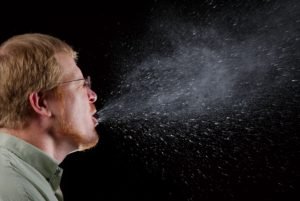 A report released this week by the Endocrine Society states that the list of health problems that scientists can confidently link to exposure to hormone-disrupting chemicals has grown to include: diabetes, cardiovascular disease, obesity, reproductive and developmental problems, thyroid impairment, certain reproductive cancers, and neurodevelopmental problems such as decreased IQ. This statement (report) is based on the summaries of 1300 studies on endocrine disrupting chemicals (EDCs), and it also adds support to the idea that even minute doses of these chemicals can interfere with the activity of natural hormones, which play a major role in regulating physiology and behavior. The statement also stated that most industrial chemicals released into the environment—numbering in the tens of thousands—have never been tested for endocrine-disrupting potential. EDCs include such common chemicals as bisphenol A (BPA), phthalates, parabens, some pesticides (e.g., atrazine), flame retardants, some persistent organic pollutants, and dioxins.
A report released this week by the Endocrine Society states that the list of health problems that scientists can confidently link to exposure to hormone-disrupting chemicals has grown to include: diabetes, cardiovascular disease, obesity, reproductive and developmental problems, thyroid impairment, certain reproductive cancers, and neurodevelopmental problems such as decreased IQ. This statement (report) is based on the summaries of 1300 studies on endocrine disrupting chemicals (EDCs), and it also adds support to the idea that even minute doses of these chemicals can interfere with the activity of natural hormones, which play a major role in regulating physiology and behavior. The statement also stated that most industrial chemicals released into the environment—numbering in the tens of thousands—have never been tested for endocrine-disrupting potential. EDCs include such common chemicals as bisphenol A (BPA), phthalates, parabens, some pesticides (e.g., atrazine), flame retardants, some persistent organic pollutants, and dioxins.
Where are endocrine disruptors found? People are exposed to chemicals with estrogenic effects in their everyday life, because endocrine disrupting chemicals are found in low doses in thousands of products. Many plastic products, including those advertised as "BPA free", have been found to leach endocrine-disrupting chemicals (the substitute chemicals are no better than BPA, and may be worse). Examples: plastic food containers which then leach into foods, linings of metal beverage, formula, and food cans, soft plastic toys, dental sealants, consumer goods, receipts, personal care products that contain parabens or phthalates (e.g., found in lotions,sunscreens, fragrances), household products (such as cleaning products, vinyl shower curtains) , cars (that new car smell in car interiors), etc. Americans love plastics, but there is a serious human health cost.
NOTE: To minimize EDC exposure - try to avoid plastic food and beverage containers. Instead try to use glass, stainless steel, or ceramics. Eat as many unprocessed and fresh foods as possible. Use cloth shower curtains. Read labels and avoid BPA, phthalates, parabens. Avoid fragrances. Don't use or buy non-stick pans, stain and water-resistant coatings on clothing, furniture and carpets. When buying new furniture, check that it doesn't have added fire retardants.
Of course any public discussion of the harms from endocrine disrupting chemicals, as well as the newly released Endocrine Society report, is drawing sharp criticisms from the chemical industry (especially the American Chemistry Council, the largest trade group for the chemicals industry). Of course. We all know that the lobbying efforts by the chemical industry to suppress and deny the evidence of harm to humans from EDCs has been and will continue to be massive. Sadly, but at this point EDCs are found in almost everyone on earth. More about the report, from Science Daily:
Chemical exposure linked to rising diabetes, obesity risk
Emerging evidence ties endocrine-disrupting chemical (EDC) exposure to two of the biggest public health threats facing society -- diabetes and obesity. EDCs contribute to health problems by mimicking, blocking or otherwise interfering with the body's natural hormones. By hijacking the body's chemical messengers, EDCs can alter the way cells develop and grow. Known EDCs include bisphenol A (BPA) found in food can linings and cash register receipts, phthalates found in plastics and cosmetics, flame retardants and pesticides. The chemicals are so common that nearly every person on Earth has been exposed to one or more. ...continue reading "New Report About Harms of Endocrine Disruptors"


 Over and over studies find that a person's diet is linked to health and diseases, and now a study finds that an unhealthy diet is linked to shrinkage of the brain, specifically the volume of the left hippocampus. The biggest effects on the hippocampus are found with
Over and over studies find that a person's diet is linked to health and diseases, and now a study finds that an unhealthy diet is linked to shrinkage of the brain, specifically the volume of the left hippocampus. The biggest effects on the hippocampus are found with  This study found something surprising in many samples of human breast tissue -
This study found something surprising in many samples of human breast tissue -  A recent post (
A recent post ( Amazing! We each release a "personal microbial cloud" with its own "microbial cloud signature" every day. The unique combination of millions of bacteria (from our microbiome or community of microbes - including bacteria, viruses, fungi - that live within and on us) can identify us. Not only do we each give off a unique combination, but we each give off different amounts of microbes - some more, some less. Some very common bacteria: Streptococcus, Propionobacterium, Corynebacterium, and Lactobacillus (among women).The microbes are given off with every movement, every exhalation, every scratching of the head, every burp and fart, etc. - and they go in the air around the person and settle around the person (they researchers even collected bacteria from dishes set on the ground around the person). From Science Daily:
Amazing! We each release a "personal microbial cloud" with its own "microbial cloud signature" every day. The unique combination of millions of bacteria (from our microbiome or community of microbes - including bacteria, viruses, fungi - that live within and on us) can identify us. Not only do we each give off a unique combination, but we each give off different amounts of microbes - some more, some less. Some very common bacteria: Streptococcus, Propionobacterium, Corynebacterium, and Lactobacillus (among women).The microbes are given off with every movement, every exhalation, every scratching of the head, every burp and fart, etc. - and they go in the air around the person and settle around the person (they researchers even collected bacteria from dishes set on the ground around the person). From Science Daily: Perhaps a nutrient deficit is associated with depression? This study found that eating a Mediterranean diet or a similar diet in which fruits, vegetables, legumes (beans), nuts, and low in processed meats is associated with lower rates of depression. From Medical Xpress:
Perhaps a nutrient deficit is associated with depression? This study found that eating a Mediterranean diet or a similar diet in which fruits, vegetables, legumes (beans), nuts, and low in processed meats is associated with lower rates of depression. From Medical Xpress: Children exposed to insecticides (pesticides) at home have an increased risk of developing leukemia or lymphoma, a new review finds.The analysis, of 16 studies done since the 1990s, found that children exposed to indoor insecticides had an elevated risk of developing the blood cancers. There was also a weaker link between exposure to weed killers and the risk of leukemia.
Children exposed to insecticides (pesticides) at home have an increased risk of developing leukemia or lymphoma, a new review finds.The analysis, of 16 studies done since the 1990s, found that children exposed to indoor insecticides had an elevated risk of developing the blood cancers. There was also a weaker link between exposure to weed killers and the risk of leukemia. It's official - the medical community has accepted that a key element in preventing allergies and asthma is early childhood exposure to allergens - whether peanuts, dust, or pets
It's official - the medical community has accepted that a key element in preventing allergies and asthma is early childhood exposure to allergens - whether peanuts, dust, or pets